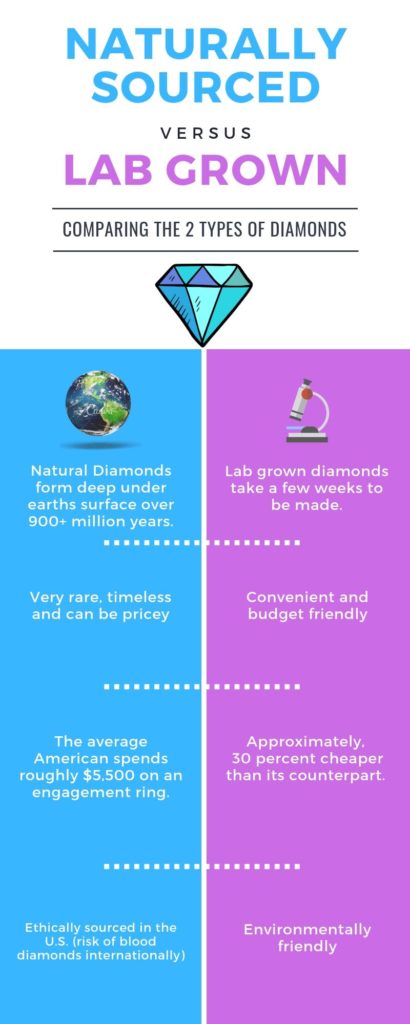The Greatest Guide To Lab Grown Diamonds
The Buzz on Lab Grown Diamonds
Table of ContentsOur Lab Grown Diamonds IdeasAbout Lab Grown DiamondsSome Known Incorrect Statements About Lab Grown Diamonds Lab Grown Diamonds Can Be Fun For EveryoneThe 45-Second Trick For Lab Grown Diamonds
Typical diamond mining can have damaging impacts on the environment and in some cases entails unethical labor practices. On the other hand, lab-grown diamonds are developed in controlled settings using sophisticated innovation. They leave a smaller sized carbon footprint and are without the ethical worries often connected with the diamond market. Lab-grown rubies offer you a chance to save significantly on your involvement ring budget without compromising top quality.What are lab-grown diamonds? How do they contrast to all-natural rubies, and are they worth it?
They are a lot more inexpensive, yet their value likely will not stand up in time. They will likewise never have the very same rarity, individuality and significance as an all-natural rock that was developed over billions of years deep in the earth. That said, we're all about options at Miriam's, and we constantly place clients.
Lab-created diamonds, likewise called man-made rubies, are grown in a laboratory. They correspond all-natural diamonds in every means, including the means they sparkle and their longevity. You can not discriminate by looking. They have the very same chemical and physical properties as diamonds found in the earth, and are thought about the very same gems under the Federal Trade Commission (FTC).
Indicators on Lab Grown Diamonds You Should Know
The process simulates the natural formation of conventional, mined diamonds, which are created deep in the earth's crust, under problems of heat and stress. A ruby's natural procedure takes billions of years to develop. On the other hand, rubies produced in a laboratory take only an issue of weeks to form.
One of the top factors to get lab-created diamonds is that they are extra budget friendly. Male made diamonds can set you back approximately 30 to 40 percent less than natural rubies of the same dimension and quality. That's due to the fact that the process of mining natural rubies is time-consuming, hard, and expensive. Rubies from a lab merely cost less to make.

There are possibly fewer environmental influences because they are not extracted from the earth, and they might be more secure to make. Nonetheless, lab-made diamonds still make use of heaps of power and take substantial factories to generate, so they may not be as environmentally-friendly as we believe. You might want to trade-in or trade-up a lab-made ruby in a couple of years, just to find it's worth pennies on what you spent for.
Lab Grown Diamonds Things To Know Before You Buy
The higher the supply, the much less valuable the product. You might pay much less to buy your diamond now, yet you likely will not get a lot, if anything, back from it later on. Natural rubies are more of an investment because they will always be a rare commodity. Because they took billions that site of years to create, there will just be a lot of all-natural rubies available in our lifetime.
Rubies are related to happy events like interactions, wedding events, and wedding anniversaries. When picking a diamond, you desire the very best you can afford. A lab-grown ruby may be the solution to finding the ideal budget-friendly piece of precious jewelry to commemorate your occasion or enjoyed one. Lab-grown rubies are recognized by a number of names.
Whatever they are called, a lab-grown ruby, true to its name, is created in a laboratory. Stress High-Heat technique, and the other is the Chemical Vapor Deposition method. The High-Pressure High-Heat approach is a simulation of the problems that result in the development of natural rubies in the midsts of the earth.
Lab Grown Diamonds Things To Know Before You Get This
Discerning in between all-natural diamonds and lab-created ones is difficult for the typical person. A diamond simulant is a stone that mimics a ruby, however it does not have just the same homes as a ruby. Cubic zirconia is one instance of an affordable ruby simulant. Moissanite is an additional example of a diamond simulant.

Nonetheless, neither of these stones is the same as a lab-created diamond. Lab-created rubies are made from carbon like all-natural rubies are. A lab-grown diamond's atomic make-up coincides as that of a natural diamond. These are real rubies, not simulants. Lab-grown diamonds have the exact same make-up Going Here as natural rubies.
The damage to ecosystems and watersheds extends well past the hole where the diamond mine is located. Between damages to natural environments and the use of nonrenewable fuel sources for running devices, ruby mines are not ecologically friendly. Lab-grown rubies, however, can be grown making use of sustainable resources to power the centers.
Unknown Facts About Lab Grown Diamonds
This is an additional factor to take into consideration a lab-grown diamond. They are approximately 40% less costly than their extracted counterparts. This means you can obtain a bigger lab-created rock for the very same cash. Or, you might pick a custom setting or better metal than you thought you would certainly be able to buy Individuals worth understanding where their treasures stem.
